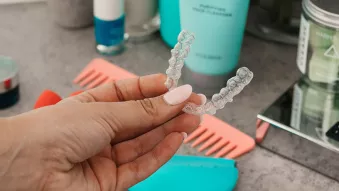Why It’s Important to Switch Aligners at the Right Time

Making the decision to pursue a happier smile is an amazing first step. If you’re choosing clear aligners to help straighten your teeth, however, you might have numerous questions about the process that you wish to address before getting started. For example, how are you supposed to know when to change aligners? How do you know if you’re changing aligners too soon? What else do you need to know before you begin the process? All of these are very valid questions and concerns that could have an impact on your experience.
To make sure that you maintain your peace of mind when you first establish an appointment with an aligner, let’s walk through some of the questions above!
How to Know When to Change Aligners: Understanding the Clear Aligners Process
Concerns surrounding switching aligners early and dealing with consequences in treatment are extremely common. However, knowing how the clear aligners process works and what you will be doing throughout your treatment can serve to ease any anxiety you might be facing.
Every aligner treatment process begins with a visit to an orthodontist that offers your designed clear aligner system. They’ll conduct a 3D scan of your mouth and use this scan to create a comprehensive treatment plan, utilising a certain number of trays to gradually shift your teeth into the desired position over time.1
Most patients may be able to address their dental issues within 10 to 20 months, but every case is different. During that period, you will most likely have to change trays every one to three weeks. Having all of this information ahead of time can make you feel less stressed about accidentally changing aligners too soon. Should an issue arise throughout the process (teeth moving too fast or too slow), your orthodontist will address these with you.1
So, should you be extremely concerned about making a mistake somewhere in the process? Absolutely not! The initial consultation and the continued check-ups provide you with the support you need to make sure that you’re getting the most out of your clear aligner system. As long as you’re following directions and not engaging in any habits that could affect your smile, you should be fine!
But what happens if you ignore directions? What if you should decide that you can determine how to know when to change aligners better than your orthodontist?

Why It’s Important to Switch Your Aligners on the Required Schedule
Sometimes, it’s not a question of how to know when to change aligners. Some patients may feel as though things are going quickly or that it might be the right time to make the switch ahead of schedule. However, switching aligners early can have a major impact on the treatment process.
When you decide to switch trays before the recommended time frame offered by your orthodontist, you run the risk of continuing to straighten some teeth while others fall behind the rest. While this may not be visible when you switch to a new tray ahead of time, these errors will make themselves known when you put on trays in the future.
The result? You can push your treatment timeline further back than you initially anticipated, necessitating the creation of new trays to fix these issues (which means more time wearing aligners than you need to and greater costs as a consequence of switching too early). Make sure to address how to know when to change aligners and what happens when you don’t switch as requested by your orthodontist before you start your treatment. This will serve as a deterrent from trying to speed up the process on your own!
How Often Do I Need to Wear Them Daily?
So, you know that you need to wear your trays for a period of one to three weeks at a time. This is helpful in knowing when to change your aligners out for a completely new tray. However, there’s something else that you need to know ahead of time: how often you should be wearing your aligners daily.
The goal for those wearing aligners is to keep them on for at least 22 hours daily** (except when eating, drinking, or engaging in your oral care practices). Should you fail to wear them for the allotted time, you won’t have to worry about changing aligners too soon as your current ones may no longer properly fit.
The best way to make sure that you’re staying on schedule is to carefully plan your day around your meal schedule. Set aside some time to figure out how often you eat and how often you’ll spend caring for your teeth afterward. Although situations are bound to come up here and there that end up using more time than you anticipate, this can help you avoid missing your mark by hours and extending your treatment deadline.
Always make sure to follow your orthodontist’s instructions to get the best possible results and avoid any potential delays in your treatment!
How Do I Get Started? Start Your SparkTM Aligners Journey Today!
If you’re looking deeper into how to know when to change aligners or what can happen when switching aligners early, you might be ready to begin your clear aligners journey. But where do you get started, and which aligners should you get started with? Now’s the perfect time to consider Spark Clear Aligners!
Comfortable and easy to wear, Spark Aligners have been shown to assist in treatment of a wide variety of malocclusions, including spacing, crowding, open bite, crossbite, underbite, and overbite. This system’s pricing is comparable to braces and to other aligners options, and they are designed for efficient and effective tooth movement. Additionally, Spark Clear Aligners are clearer, more comfortable, and stain less. *
Ready to address questions like how to know when to change aligners and discover your individual treatment plan? Find a Spark Aligners Provider and start perfecting your smile today!



